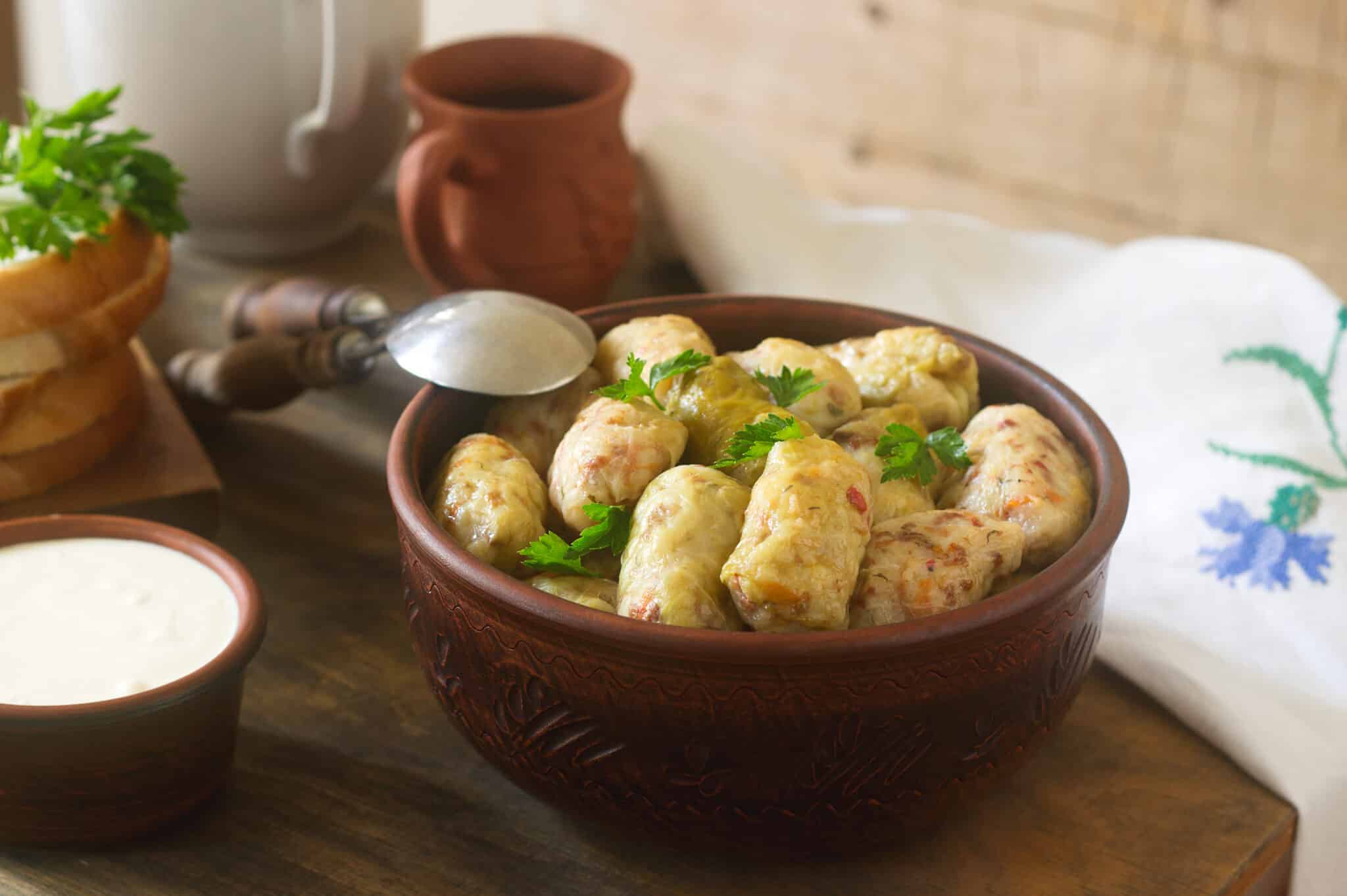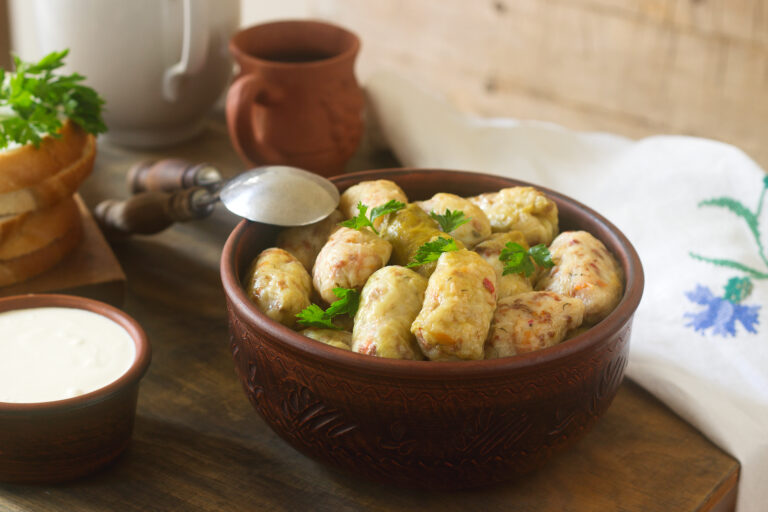 Romanian Sarmale, the stuffed cabbage rolls, is a beloved dish that represents the rich culinary heritage of Romania. Whether enjoyed during the holidays or as a comforting meal year-round, Sarmale is a true taste of Romanian tradition.
Romanian Sarmale, the stuffed cabbage rolls, is a beloved dish that represents the rich culinary heritage of Romania. Whether enjoyed during the holidays or as a comforting meal year-round, Sarmale is a true taste of Romanian tradition.
Our team at Remitly created this guide as part of our series that celebrates the traditional foods of our global customers. Read on for a recipe and more!
Romania, a central European country rich in culture and traditions, boasts a culinary heritage that is as diverse as it is delicious. Among the many delectable dishes found in Romanian cuisine, one stands out as the national favorite: Sarmale, also known as Romanian Cabbage Rolls. This hearty dish is a staple in Romanian households and is often enjoyed on special occasions such as Christmas and Easter.
The History of Sarmale
Sarmale has its roots in Eastern Europe and shares similarities with other stuffed cabbage roll dishes found in countries like Poland, Germany, and even the Polish version known as “Golabki.” The dish has a long history, with variations that reflect the unique culinary traditions of each region.
In Romania, Sarmale holds a special place in the hearts of the people and is considered a quintessential part of their culinary heritage. It’s often prepared with love and care during festive seasons like Christmas and Easter, making it a symbol of togetherness and celebration.
Ingredients for Romanian Sarmale
For the Cabbage Rolls:
- 2 large cabbage heads
- 500g ground pork
- 250g ground beef
- 1 cup white rice
- 1 large onion, chopped
- 2 cloves garlic, minced
- 2 tablespoons paprika
- Salt and black pepper to taste
- 2 bay leaves
- Fresh parsley and dill for garnish
- Smoked bacon (optional)
For the Sauerkraut Layer:
- 1 large jar of pickled cabbage or sauerkraut
- 2-3 smoked meat items (e.g., smoked bacon, sausages)
For the Tomato Sauce:
- 2 cups tomato juice
- 2 tablespoons tomato paste
For Serving:
- Sour cream
- Mamaliga (Romanian polenta)
Preparation of Romanian Cabbage Rolls (Sarmale)
Prep Time: 1 hour
Cook Time: 2-3 hours
Total Time: 3-4 hours
- Prepare the Cabbage Leaves: Boil a large pot of water. Carefully peel off the large leaves from the cabbage heads. Blanch these leaves in the boiling water for a few minutes until they become pliable. Remove and set aside.
- Prepare the Filling: In a large bowl, combine the ground pork, ground beef, rice, chopped onion, minced garlic, paprika, salt, and black pepper. Mix the ingredients thoroughly to create the meat mixture.
- Roll the Sarmale: Place a cabbage leaf on a clean surface and add a spoonful of the meat mixture in the center. Fold the sides of the cabbage leaf over the filling, then roll it up tightly. Repeat this process until all the filling is used.
- Layer the Sauerkraut: In a large pot, layer the bottom with sauerkraut or pickled cabbage. Add the smoked meat items on top.
- Arrange the Cabbage Rolls: Carefully place the cabbage rolls on top of the sauerkraut layer. Add bay leaves for flavor.
- Prepare the Tomato Sauce: Mix tomato juice and tomato paste in a separate bowl, then pour this tomato sauce over the cabbage rolls.
- Cook the Sarmale: Cover the pot and simmer on medium heat for 2-3 hours, allowing the flavors to meld together.
- Serve: Serve the Sarmale hot, garnished with fresh parsley and dill, and accompanied by sour cream and mamaliga.
Sarmale is a delightful dish that combines the flavors of sour cabbage, savory meat, and aromatic spices, resulting in a harmonious blend that will transport you to the heart of Romania.
Nutritional Information
- Calories: Approximately 400 kcal per serving
- Carbohydrates: 40g
- Cholesterol: 60mg
The Broader Cuisine of Romania
Romanian cuisine is diverse and hearty—reflecting its rich history and cultural influences.
Popular Dishes in Romania
Aside from Sarmale, other popular dishes include Mămăligă (a type of polenta), Mititei (grilled meatballs), Ciorbă de burtă (tripe soup), and Papanasi (a sweet cheese-filled doughnut).
These dishes, like Sarmale, are often enjoyed during special occasions but can also be found in everyday meals—showcasing the versatility of Romanian cuisine.
- Mămăligă: Often called Romanian polenta, mămăligă is a staple side dish made from boiled cornmeal. It’s served as a thick porridge, sliced, or fried, and pairs well with various stews and sauces.
- Mici: These skinless grilled sausages, also known as “țuică cârnați,” are a favorite Romanian street food. They are made from a mixture of minced pork, beef, and spices, delivering a flavorful and juicy experience.
- Ciorbă de Burtă: A tangy and hearty tripe soup, ciorbă de burtă is a traditional Romanian dish. The sourness comes from fermented wheat bran and is balanced with sour cream and fresh herbs.
- Mămăligă cu Brânză și Smântână: A delightful comfort food, this dish features mămăligă topped with salty sheep cheese and a dollop of sour cream. It’s simple yet satisfying.
- Mici cu Mămăligă și Muștar: Mici served with mămăligă (polenta) and mustard is a classic Romanian meal. The juicy sausages complement the creamy polenta perfectly.
- Mitrăței: These Romanian meatballs are made from a blend of minced pork and beef mixed with spices and herbs. They are typically fried until golden brown and are often enjoyed with a side of pickles.
- Tochitură Moldovenească: Hailing from the Moldova region, this hearty pork stew features tender chunks of pork cooked with onions, garlic, and paprika. It’s often served with mămăligă and a fried egg on top.
- Ciorbă de Perișoare: Romanian meatball soup is a flavorful and hearty dish made with ground meat, rice, and various herbs, all cooked in a tangy broth. It’s a beloved comfort food, especially during the colder months.
- Mucenici: These sweet pastries are shaped like the number “8” and traditionally enjoyed on March 9th during the Mucenici holiday. They are made from a mixture of flour, honey, and walnuts, offering a delightful taste of Romanian dessert culture.
Romanian food culture is deeply rooted in tradition and reflects the country’s history and geography. It places a strong emphasis on hearty, filling dishes prepared using locally sourced ingredients.
Visit the homepage, download our app, or check out our Help Center to get started.
